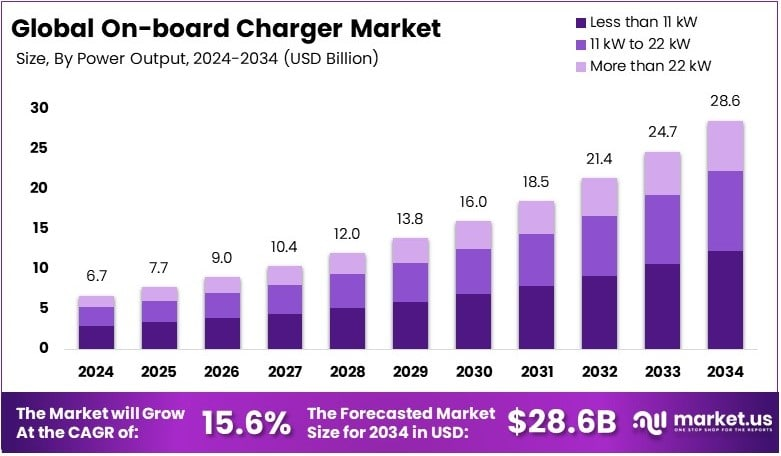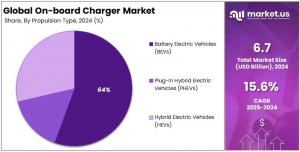
On-board Charger Market Expected to Reach USD 28.6 Billion by 2034, Growing at a CAGR of 15.6%

On-board Charger Market Growth Analysis
On-board Charger Market is expected to reach USD 28.6 Billion by 2034, growing at a CAGR of 15.6% from USD 6.7 Billion in 2024.
NEW YORK, NY, UNITED STATES, January 27, 2025 /EINPresswire.com/ -- **Report Overview**
The Global On-board Charger Market is projected to reach USD 28.6 billion by 2034, growing from USD 6.7 billion in 2024, at a compound annual growth rate (CAGR) of 15.6% from 2025 to 2034.
An on-board charger (OBC) is a crucial component of electric vehicles (EVs) that facilitates the efficient conversion of AC power from charging stations into DC power to charge the vehicle's battery. Designed to integrate seamlessly within the vehicle's architecture, the OBC enables flexibility by allowing EV owners to utilize standard electrical outlets or dedicated EV charging infrastructure. This component plays a pivotal role in ensuring a reliable and optimized charging experience, contributing to the overall performance, convenience, and safety of electric mobility.
The on-board charger market is experiencing rapid growth, driven by the increasing global adoption of electric vehicles amid rising environmental concerns and stringent emissions regulations. This market encompasses a range of OBC technologies, including single-phase and three-phase systems, with applications spanning passenger vehicles, commercial vehicles, and two-wheelers. As automakers strive for lighter, more efficient, and compact charging systems, advancements in power electronics and semiconductor technologies are fueling innovation within the OBC sector.
Key growth factors include the escalating demand for EVs due to governmental incentives, growing investments in charging infrastructure, and advancements in battery technology. Additionally, the rising consumer preference for fast-charging capabilities and extended driving ranges further accelerates the adoption of sophisticated OBC systems.
The surging demand for electric mobility, especially in emerging markets, presents significant opportunities for manufacturers to expand their footprint and offer customized solutions tailored to regional requirements. As the global EV ecosystem matures, the on-board charger market is poised for sustained growth, fostering innovation and competition across the automotive value chain.
Request Your Sample Report Today for In-Depth Insights and Analysis at https://market.us/report/on-board-charger-market/request-sample/
**Key Takeaways**
~~ The on-board charger market was valued at USD 6.7 Billion in 2024 and is projected to reach USD 28.6 Billion by 2034, growing at a CAGR of 15.6%.
~~ The Less than 11 kW category dominates with a 43% share, driven by its widespread use in residential and smaller commercial applications.
~~ Passenger Cars lead with 51%, fueled by the rapid growth of electric vehicle (EV) adoption globally.
~~ Battery Electric Vehicles (BEVs) hold the majority share at 64%, as BEVs are the primary drivers of on-board charger demand.
~~ Residential Charging leads, reflecting the increasing trend of home-based EV charging solutions.
~~ Asia-Pacific holds the largest market share at 44%, contributing USD 2.95 Billion, primarily due to the region’s strong electric vehicle production and adoption.
**Market Segmentation**
In the On-board Charger Market, chargers with a power output of less than 11 kW hold the largest share at 43%. This is due to their compatibility with standard home electrical systems, making them ideal for daily overnight EV charging. Chargers with 11 kW to 22 kW are preferred for faster charging, while those over 22 kW are used in commercial and public stations for high-speed charging.
Passenger Cars lead the On-board Charger Market with a 51% share, driven by the growing adoption of electric vehicles (EVs) and supportive government policies. Light and Heavy Commercial Vehicles, along with Electric Two-Wheelers, also contribute to market growth as urban fleets and consumers seek more efficient, eco-friendly transportation solutions.
Battery Electric Vehicles (BEVs) lead the propulsion type segment with 64% market share, driven by the growing preference for fully electric, zero-emission vehicles. Plug-In Hybrid Electric Vehicles (PHEVs) and Hybrid Electric Vehicles (HEVs) also use on-board chargers, but PHEVs can extend their electric range by charging externally, while HEVs primarily rely on regenerative braking for battery charging.
Residential Charging is the largest application segment for on-board chargers, driven by the convenience and cost-effectiveness of home-based charging. EV owners can charge overnight, ensuring their vehicles are ready each day. Commercial/Public Charging also plays a key role, providing essential infrastructure for users who need to charge away from home, especially during long trips or in urban areas with limited private parking.
**Key Market Segments**
By Power Output
~~ Less than 11 kW
~~ 11 kW to 22 kW
~~ More than 22 kW
By Vehicle Type
~~ Passenger Cars
~~ Light Commercial Vehicles (LCVs)
~~ Heavy Commercial Vehicles (HCVs)
~~ Electric Two-Wheelers
By Propulsion Type
~~ Battery Electric Vehicles (BEVs)
~~ Plug-In Hybrid Electric Vehicles (PHEVs)
~~ Hybrid Electric Vehicles (HEVs)
By Application
~~ Residential Charging
~~ Commercial/Public Charging
**Driving factors**
Increasing Adoption of Electric Vehicles (EVs)
The global rise in electric vehicle (EV) adoption remains one of the most influential drivers for the On-board Charger (OBC) market in 2024. As governments around the world introduce stringent emission regulations and provide incentives for cleaner energy, more consumers and businesses are shifting toward electric mobility. The transition to EVs not only aligns with sustainability goals but also reduces dependency on fossil fuels, driving up demand for EV infrastructure, including on-board chargers. The increasing number of electric vehicle models available at different price points has further accelerated this trend, making EVs more accessible to a broader range of consumers.
"Order the Complete Report Today to Receive Up to 30% Off at https://market.us/purchase-report/?report_id=16745
**Restraining Factors**
High Manufacturing and Integration Costs
One of the primary restraints for the On-board Charger market is the high manufacturing and integration costs associated with advanced charging technologies. On-board chargers, especially those designed for fast charging capabilities, require significant investments in high-quality components, such as power semiconductors, thermal management systems, and high-voltage capacitors. These high-performance components not only raise the cost of production but also add to the overall price of the electric vehicle. This price barrier can be a significant deterrent for consumers, especially in price-sensitive markets where affordability remains a major concern.
**Growth Opportunity**
Expansion of Fast Charging Infrastructure
A notable opportunity for growth in the On-board Charger market lies in the expansion of fast charging infrastructure. As EV adoption accelerates, so does the demand for efficient and time-saving charging solutions. Fast charging technology, which reduces charging time from several hours to a matter of minutes, has become a critical aspect of consumer EV adoption. The ability to provide rapid and convenient charging options will drive the growth of on-board chargers capable of supporting ultra-fast charging standards, such as DC fast charging (DCFC).
**Latest Trends**
Smart Charging and Vehicle-to-Grid (V2G) Technology
A key trend shaping the On-board Charger market in 2024 is the increasing integration of smart charging and Vehicle-to-Grid (V2G) technology. Smart charging systems are being designed to offer more than just a standard charging process; they can monitor and optimize energy usage, and provide dynamic charging based on grid demand. These systems enable the integration of renewable energy sources and help stabilize the power grid by adjusting charging speed and time to match energy availability. As energy efficiency and sustainability become central to EV adoption, smart charging solutions are becoming an essential feature in new EVs and charging stations.
**Regional Analysis**
Asia-Pacific On-board Charger Market with Largest Market Share of 44%
The on-board charger market is led by Asia-Pacific, which holds the largest market share of 44% in 2023, valued at USD 2.95 billion. This growth is driven by the rapid adoption of electric vehicles (EVs) and strong government support in countries like China, Japan, and South Korea.
North America also shows steady growth, fueled by increasing EV adoption and government incentives, particularly in the U.S. Europe follows with strong EV penetration and stringent emission regulations, with key markets like Germany and the Netherlands leading the way.
The Middle East & Africa market is emerging, with increasing investments in sustainable transportation, while Latin America, although smaller, is seeing growth in countries like Brazil and Mexico.
Asia-Pacific remains the dominant region, holding the largest share and spearheading advancements in the on-board charger market.
!! Request Your Sample PDF to Explore the Report Format !!
**Key Players Analysis**
In 2024, the global on-board charger (OBC) market is expected to witness heightened competition and innovation, with key players such as Delphi Technologies, BorgWarner Inc., and Continental AG leading the charge. Delphi Technologies, now a part of BorgWarner, is leveraging its advanced power electronics and charging solutions to meet the rising demand for efficient EV charging systems. BorgWarner’s strong focus on electrification has enabled it to diversify its OBC offerings, gaining a foothold in the rapidly growing EV market. Continental AG continues to expand its position with high-performance OBC systems focused on safety, energy efficiency, and compactness.
Robert Bosch GmbH is capitalizing on its automotive legacy, providing integrated OBC solutions for various EV models. STMicroelectronics and Texas Instruments are key players in the semiconductor space, offering robust charging ICs, while Analog Devices and Infineon Technologies are pushing the envelope in power management and efficiency. Delta Electronics, with its sustainable energy solutions, and LG Electronics are also contributing with cutting-edge, user-centric on-board charging technologies, making a significant impact on the market’s growth trajectory.
Top Key Players in the Market
~~ Delphi Technologies
~~ BorgWarner Inc.
~~ Continental AG
~~ Robert Bosch GmbH
~~ STMicroelectronics
~~ Texas Instruments Incorporated
~~ Analog Devices, Inc.
~~ Delta Electronics, Inc.
~~ Infineon Technologies AG
~~ LG Electronics Inc.
**Conclusion**
The on-board charger market is poised for significant growth, driven by the global shift toward electric vehicles (EVs) and the increasing demand for efficient and fast-charging solutions. With a projected market size of USD 28.6 billion by 2034, growing at a CAGR of 15.6%, the sector is benefiting from advancements in power electronics, battery technology, and government incentives supporting clean energy. Key trends, such as the rise of smart charging and Vehicle-to-Grid (V2G) systems, further enhance the potential of this market. However, challenges like high manufacturing costs remain, but the expansion of fast-charging infrastructure presents ample opportunities for innovation and market expansion. Leading players like Delphi Technologies, BorgWarner, and Continental AG are well-positioned to drive the future of this dynamic and competitive market.
Lawrence John
Prudour
+91 91308 55334
email us here
Visit us on social media:
Facebook
LinkedIn
Distribution channels: Consumer Goods
Legal Disclaimer:
EIN Presswire provides this news content "as is" without warranty of any kind. We do not accept any responsibility or liability for the accuracy, content, images, videos, licenses, completeness, legality, or reliability of the information contained in this article. If you have any complaints or copyright issues related to this article, kindly contact the author above.
Submit your press release

